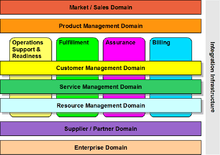Telecom Application Map

The TM Forum Applications Framework is produced by the TM Forum. The TM Forum is the world’s industry association of web, telecom and media companies focused on end-end service management. The TM Forum’s Frameworx - is a comprehensive, integrated set of tools for defining, developing, procuring and deploying operational and business support systems and software. The scope covers the complete OSS / BSS development lifecycle.
Frameworx comprises a packaged set of industry-agreed guidelines; maps; models; methodologies, specifications, a developers’ toolkit and standardized interface definitions to guide the definition, development, procurement, and deployment of interoperable OSS/BSS solutions.These Frameworx artifacts, and the clearly defined methodology for using them, assist the user to define, design and build Frameworx solutions that can easily integrate into any Frameworx compliant environment.
The TM Forum Applications Framework or the TAM (Telecom Application Map) is one of the primary Frameworx artifacts. It considers the role and the functionality of the various applications that deliver OSS (Operations Support System) and BSS (Business Support System) capability. Structured along similar lines to other TM Forum artifacts: the business process framework – the eTom and the information framework – the SID, it is presented in a similar layered and vertical structure.
In doing so it enables procurement documents to be written with reference to the framework, thereby providing clear unambiguous statements of the functionality required of any given application, functional overlaps of existing applications to be identified, thereby facilitating rationalization and functional gaps to be identified.
The level of functional decomposition is such that these benefits can be realized but without being over prescriptive.
Within the TM Forum there is a strong definition of process (the eTOM) and data (the SID). The TM Forum Applications Framework provides a formalized way of grouping together function and data into recognised components, which would then be regarded as potentially procurable as either applications or services. An application or service (for example: web services) can be a relatively coarsely grained software that implements functions/processes and acts on or uses data. In daily life we see applications such as word processors or mail clients; in OSS terms we would regard an application as something such as a CRM component, a billing system or an inventory solution – although we also understand that these can be decomposed to some extent – for example a billing system will include a number of smaller applications, such as a rating engine.
An “application” is defined as a set of one or more software artifacts comprising well defined functions, data, business flows, rules and interfaces. This would include a Data Model, for data used to interface to and within an application, policies, for governing external and internal application resources, a Flow Model, for functionality with the application and contract specifications for externally visible interfaces to the functionality within the application
Applications are implement-able as deployable packages and are procurable in the system market place.
The Application Framework is not a part of either the SID or the eTOM definitions but links to both in an easily understandable way and also provide a mapping between the telecom application map eTOM and SID.